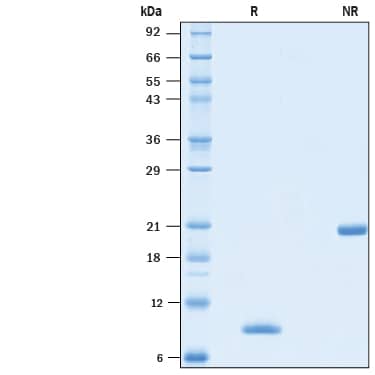Recombinant Human BMP-4 Animal-Free Protein
R&D Systems, part of Bio-Techne | Catalog # AFL314E
Intended for preclinical researchers who may transition to GMP BMP-4 for their clinical work

Key Product Details
Learn more about Animal-Free Recombinant Proteins
Source
E. coli
Accession #
Structure / Form
Disulfide-linked homodimer
Conjugate
Unconjugated
Applications
Bioactivity
Product Specifications
Source
E. coli-derived human BMP-4 protein
Lys303-Arg408
Produced using non-animal reagents in an animal-free laboratory.
Lys303-Arg408
Produced using non-animal reagents in an animal-free laboratory.
Purity
>95%, by SDS-PAGE visualized with Silver Staining and quantitative densitometry by Coomassie® Blue Staining.
Endotoxin Level
<0.10 EU per 1 μg of the protein by the LAL method.
N-terminal Sequence Analysis
Lys303
Predicted Molecular Mass
12 kDa
SDS-PAGE
8-9 kDa, under reducing conditions
Activity
Measured by its ability to induce BMP responsive SEAP reporter activity in HEK293 human embryonic kidney cells.
The ED50 for this effect is 3.00-21.0 ng/mL.
The ED50 for this effect is 3.00-21.0 ng/mL.
Scientific Data Images for Recombinant Human BMP-4 Animal-Free Protein
Recombinant Human BMP-4 Animal-Free Protein Bioactivity
Measured by its ability to induce BMP responsive SEAP reporter activity in HEK293 human embryonic kidney cells. The ED50 for this effect is 3-21 ng/mL.Equivalent Bioactivity of GMP, Animal-Free, and RUO grades of Recombinant Human BMP-4.
Equivalent bioactivity of GMP (314-GMP), Animal-Free (Catalog # AFL314E) and RUO (314-BPE) grades of Recombinant Human BMP-4 as measured by its ability to induce BMP responsive SEAP reporter activity in HEK293 human embryonic kidney cells (orange, green, red, respectively).Recombinant Human BMP-4 Animal-Free Protein SDS-PAGE
2 μg/lane of Animal-FreeTM Recombinant Human BMP-4 Protein (AFL314E) was resolved with SDS-PAGE under reducing (R) and non-reducing (NR) conditions and visualized by Coomassie® Blue staining, showing bands at 8-9 kDa and 20-22 kDa, respectively.Formulation, Preparation and Storage
AFL314E
| Formulation | Lyophilized from a 0.2 μm filtered solution in Acetonitrile and TFA. |
| Reconstitution | Reconstitute at 100-200 μg/mL in 4 mM HCl. |
| Shipping | The product is shipped at ambient temperature. Upon receipt, store it immediately at the temperature recommended below. |
| Stability & Storage | Use a manual defrost freezer and avoid repeated freeze-thaw cycles.
|
Background: BMP-4
References
- Zhang, P. et al. (2008) Blood 111:1933.
- Gambaro, K. et al. (2006) Cell Death Differ. 13:1075.
- Simic, P. and S. Vukicevic (2005) Cytokine Growth Factor Rev. 16:299.
- Sadlon, T.J. et al. (2004) Stem Cells 22:457.
- Frank, D.B. et al. (2005) Circ. Res. 97:496.
- Lee, J-H. et al. (2014) Cell. 156:440.
- Tang, QQ. et Lane MD. (2012) Annu Rev. Biochem. 81:715.
- Urist, MR. (1965). Science. 150:893.
- Bandyopadhyay, A. et al. (2006) Plos Genetics. 2:e216.
- Wozney, J. et al. (1988) Science 242:1528.
- Cui, Y. et al. (1998) EMBO J. 17:4735.
- Cui, Y. et al. (2001) Genes Dev. 15:2797.
- Aono, A. et al. (1995) Biochem. Biophys. Res. Commun. 210:670.
- Nishimatsu, S. and G.H. Thomsen (1998) Mech. Dev. 74:75.
- Chen, D. et al. (2004) Growth Factors 22:233.
- Lavery, K. et al. (2008) J. Biol. Chem. April 24 epub.
- Rosen, V. (2006) Ann. N.Y. Acad. Sci. 1068:19.
- Jones, C.M. and J.C. Smith (1998) Dev. Biol. 194:12.
- Takada, T. et al. (2003) J. Biol. Chem. 278:43229.
Long Name
Bone Morphogenetic Protein 4
Alternate Names
BMP2B, BMP2B1, BMP4, MCOPS6, OFC11
Gene Symbol
BMP4
UniProt
Additional BMP-4 Products
Product Documents for Recombinant Human BMP-4 Animal-Free Protein
Manufacturing Specifications
Animal-Free Manufacturing ConditionsOur dedicated controlled-access animal-free laboratories ensure that at no point in production are the products exposed to potential contamination by animal components or byproducts. Every stage of manufacturing is conducted in compliance with R&D Systems' stringent Standard Operating Procedures (SOPs). Production and purification procedures use equipment and media that are confirmed animal-free.
Production
- All molecular biology procedures use animal-free media and dedicated labware.
- Dedicated fermentors are utilized in committed animal-free areas.
Purification
- Protein purification columns are animal-free.
- Bulk proteins are filtered using animal-free filters.
- Purified proteins are stored in animal-free containers in a dedicated cold storage room.
- Low Endotoxin Level.
- No impairment of biological activity.
- High quality product obtained under stringent conditions.
- For ex vivo research or bioproduction, additional documentation can be provided.
Product Specific Notices for Recombinant Human BMP-4 Animal-Free Protein
For research use only
